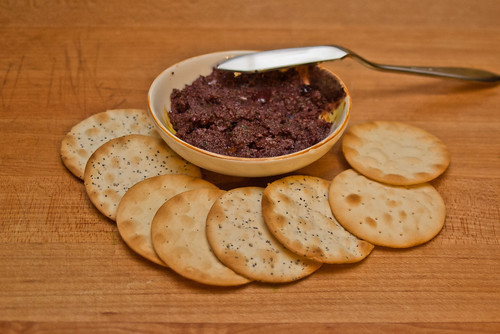- Eating a piece of plain grilled chicken or fish and wishing you could jazz it up?
- Making a sandwich and discovering that you're out of mayo and mustard?
- Putting out crackers or sliced baguettes for company, but missing just one more spread for them?
Enter olive tapenade. From Wikipedia:
Tapenade is a Provençal dish consisting of puréed or finely chopped olives, capers, anchovies and olive oil. Its name comes from the Provençal word for capers, tapenas.Well, doesn't that sound fancy! However, your Slacker Gourmet alarm bells are probably going off. Finely chopped? Capers? ANCHOVIES? Breathe, people! Let's break this down:
- You don't have to chop anything up into itty bitty pieces, as long as you have a food processor or stick blender. Traditionally some tapenades were made with a mortar and pestle - we're definitely not going down that road either.
- Yes, capers are one of those items you've typically bought for one recipe and one recipe only. They usually come in expensive little jars, of which you use 7/8ths for the aforementioned recipe. But - if you find yourself at Trader Joe's or an Italian grocery (not just a specialty shop), they sell capers in larger jars, and if you keep 'em in the fridge in their brine, they last for quite awhile. If you have them around on a regular basis, you'll find yourself using them in pasta/grain salads, stews, chicken sautés, or anything that needs a briny kick. However, if you still don't want to buy them, they are NOT essential to my quick tapenade recipe (which I suppose would technically make it an olive relish instead, but whatever).
- Anchovies? So not necessary. If you happen to have them around, sure, go ahead and throw a fillet in, but there's no reason to go out and buy them.
A little more explanation on the puréeing technique: typically a food processor is the easiest tool for the job. But - this recipe only makes a cup or so of tapenade, so if you have a 14-cup food processor and can't find your little mini processor, it's definitely not worth getting the big processor dirty if you have a stick blender.
Easy Olive Tapenade
Makes 1 - 1 1/2 cups
Ingredients
- 1 1/2 cups pitted olives, rinsed (this is important!) and divided (any kind, or a mix - see notes above)
- 2 tablespoons capers (optional - use a mix of olives if not using)
- 1 whole clove garlic
- 1/2 - 1 tablespoon fresh parsley, basil, or oregano (optional)
- 1/2 - 1 tablespoon lemon juice or red wine vinegar
- 2 tablespoons olive oil
- Fresh cracked black pepper
Directions
Food Processor:
Combine 1 cup olives, capers (if using), garlic, herbs (if using), and 1/2 tablespoon lemon juice or red wine vinegar in the food processor bowl. Pulse until all components are between chunky and finely chopped. Drizzle olive oil in while processing until the mixture comes together and looks almost like a paste. Add the reserved 1/2 cup of olives and pulse until the new addition is coarsely chopped - this will add some extra texture. Taste and add the additional 1/2 tablespoon of lemon juice/vinegar if necessary, and stir in pepper to taste.
Stick Blender:
In the smoothie cup that comes with your stick blender, or a medium bowl, combine 1 cup olives, capers (if using), garlic, herbs (if using), and 1/2 tablespoon lemon juice or red wine vinegar. Hit it with the stick until the texture is between chunky and finely chopped. Add the olive oil all at once, and hit it with the stick again, until the mixture looks like a rough paste. Add the reserved 1/2 cup of olives and give it another hit with the stick until those olives are coarsely chopped and the tapenade looks like it has a variety of textures. Taste and add the additional 1/2 tablespoon of lemon juice/vinegar if necessary, and stir in pepper to taste.
Okay, now you have tapenade, and it should keep for at least a week in the fridge. Now, what can you do with it?
- Use it as a relish for grilled chicken or fish.
- Slather it on raw chicken or fish, wrap in parchment paper or foil, and bake for 15 minutes (thin cuts of fish), 20-25 minutes (thicker cuts of fish), 30-40 minutes (chicken) at 350 degrees.
- Use as a delicious sandwich spread (especially on a Mediterranean-inspired sandwich)
- Spread it on baguette slices or crackers for an elegant appetizer. If you want to jazz up the spreading platform, brush baguette slices with garlic olive oil and toast in the oven or toaster oven until golden brown.
- Toss it with cooked pasta and top with a sprinkle of Parmigiano-Reggiano for a quick meal or side dish.
- My mother, a dyed-in-the-wool New Yorker, once suggested using tapenade as a non-dairy/non-fish spread alternative to cream cheese and lox - and let me tell you, it's darn tasty! You get that nice saltiness without the fishiness, which is a huge bonus for my smoked-salmon-hating hubby.


No comments:
Post a Comment